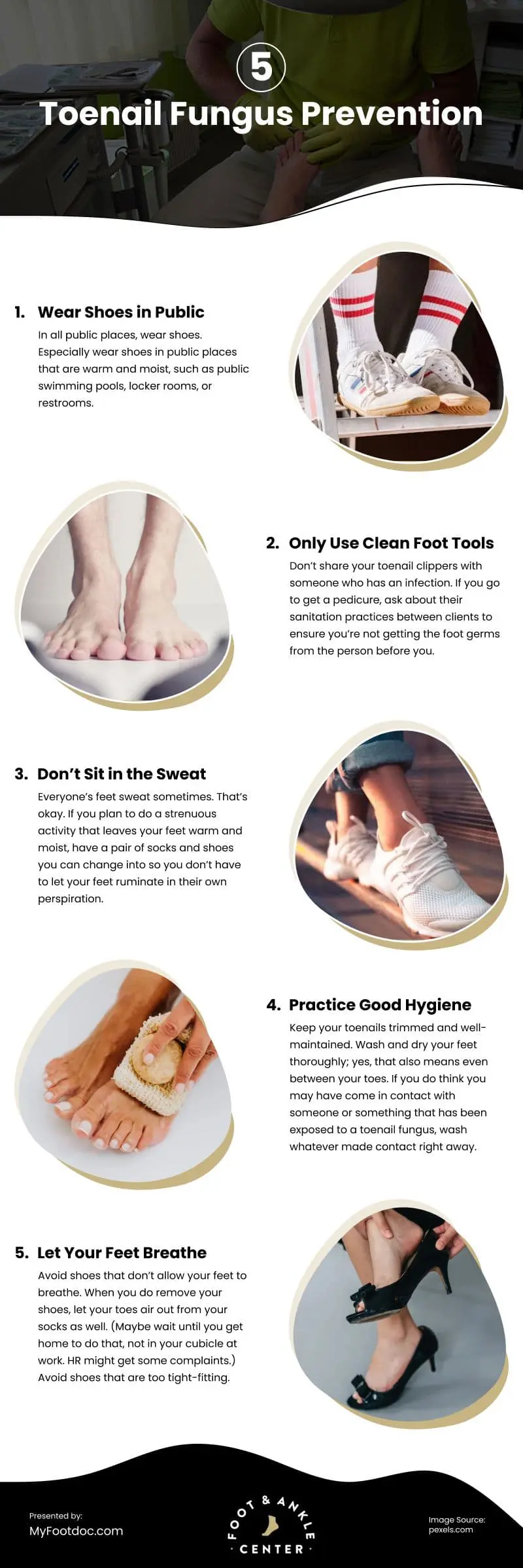No one is safe from the potential of developing a toenail fungus, but you can make smart choices that will lower your risk of it. Educating yourself and making wise decisions can help safeguard your toenails against the uncomfortable plight of a fungal infection. We have put together a guide to help you learn all about common causes, risk factors, symptoms, treatment, and prevention of toenail fungus.
Causes of Toenail Fungus
Toenail fungus is developed after microscopic fungi come in contact with your toenail. Fungi can travel through direct contact with an infected toenail, skin-to-skin contact with someone harboring a fungal infection, or indirect contact (through shared nail clippers, towels, locker rooms, etc.).
Toenail fungus can also develop without initial exposure. Moist and warm feet will contract a toenail fungus, so beware if your feet are frequently in sweaty socks and shoes.
The microscopic fungi enter your body via cracked skin, cracked nails, or the point where the skin and nail meet. These areas provide a warm and moist environment, which is ideal for fungal growth and spreading.
Fun fungi fact: the same fungus that causes toenail fungus is the culprit behind athlete’s foot, jock itch, and ringworm.
Toenail Fungus Risk Factors
Who is most susceptible to developing toenail fungus? Let’s take a look at the risk factors:
- Environment. Fungus loves warmth and moisture. If you live in a warm and humid climate, you are at a higher risk of developing toenail fungus.
- Age. Your chances of developing toenail fungus increase as the number of candles on your birthday cake increases. Children rarely develop toenail fungus.
- Lifestyle. Some choices can increase your risk of developing a toenail fungus. Here are some:
- Smoking
- Walking barefoot in public
- Wearing tight shoes
- Frequently getting feet wet
- Health. Some health conditions can make you more likely to develop toenail fungus. Here are some:
- Poor circulation
- Cancer
- Psoriasis
- Athlete’s foot
- Diabetes
- Organ transplant
- Immunodeficiency
- Nail injury
- Nail infection
- Sweaty feet
Symptoms of Toenail Fungus
If you suspect you may have developed a toenail fungus, here are the symptoms you can look out for:
- Odor from the nail
- Lifting the nail from the nail bed
- Dry or brittle nail
- Loss of nail
- Distorted nail
- Thickened nail
- Yellow streaks on the nail
- Disintegration of the nail
Toenail Fungus Treatment
The first thing you should do if you suspect you have developed a toenail fungus is to do an internet search for a “podiatrist near me.” While over-the-counter toenail fungus treatments may alleviate symptoms, they won’t be able to fight the infection completely.
A prescription oral antifungal medication from a podiatrist can help completely eradicate the fungal infection from your entire body.
Preventing Future Toenail Fungus
If you never want to deal with toenail fungus again in the future (or at all if you haven’t had it yet), you can take some steps to lower your risk.
Wear Shoes in Public
In all public places, wear shoes. Especially wear shoes in public places that are warm and moist, such as public swimming pools, locker rooms, or restrooms.
Only Use Clean Foot Tools
Don’t share your toenail clippers with someone who has an infection. If you go to get a pedicure, ask about their sanitation practices between clients to ensure you’re not getting the foot germs from the person before you.
Wash your towel frequently. Wear clean socks. And clean your feet regularly, too.
Don’t Sit in the Sweat
Everyone’s feet sweat sometimes. That’s okay. If you plan to do a strenuous activity that leaves your feet warm and moist, have a pair of socks and shoes you can change into so you don’t have to let your feet ruminate in their own perspiration.
Practice Good Hygiene
Keep your toenails trimmed and well-maintained. Wash and dry your feet thoroughly; yes, that also means even between your toes. If you do think you may have come in contact with someone or something that has been exposed to a toenail fungus, wash whatever made contact right away.
Let Your Feet Breathe
Avoid shoes that don’t allow your feet to breathe. When you do remove your shoes, let your toes air out from your socks as well. (Maybe wait until you get home to do that, not in your cubicle at work. HR might get some complaints.) Avoid shoes that are too tight-fitting.
With all this newfound knowledge and a little common sense, you can now be prepared to avoid all future toenail fungus problems.
Infographic
Toenail fungus can affect anyone, but you can reduce your risk by making informed choices. If you want to avoid dealing with it in the future, consider taking steps to protect your toenails. Read on for more tips in this infographic.




